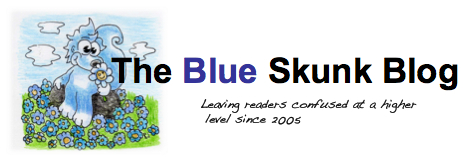BFTP: The gift of creativity
 Saturday, January 1, 2011 at 09:01AM
Saturday, January 1, 2011 at 09:01AM A Saturday Blue Skunk "feature" will be the revision of an old post. I am calling this BFTP: Blast from the Past. This post originally appeared December 26, 2005.
Toys opened last night. Roboraptor was a huge hit. I did not know it, but it was on 4-year-old Paulie's wish list, but vetoed by his mom and dad as too expensive. Paul was so excited he could barely talk (which is almost impossible for that little chatterbox). The cats see the robot as their own very large squeaky toy with a tail that is eminently bat-able.
For Paul some toys become "real." They are beings with back stories and are worthy of care and concern. His vivid imagination and storytelling ability regarding them is seemingly limitless. Whether the subject is his invisible sister Jessica (for whom we must leave the bathroom door open), Snakey his favorite giant blue rubber snake, or now Roboraptor, each of the characters in Paul's mental world has dozens of details that come directly from somewhere in his creative center. As a grandfather, it's difficult not to think Paul is a uniquely talented boy of superior genetic make-up, but my experience is that all children are inherently creative. And we then do our best as educators to bleed it from them.

Of course educators pay a lot of lip service to encouraging creativity in our students, but do we really? Creativity seems to have been relegated to art classes. (See Concerns about Creativity.) Oh, we throw in a "fun" writing assignment among the three paragraph expository essays, but most of the time we discourage originality through stay-within-the-line rules, one-right-answer tests, must-be-followed templates, and praise for conformity.
If I had one wish for Paul and all students this coming year, it would be that every teacher builds the expectation of creative thinking and communication into each assignment.
Such a wish is not just fuzzy, feel-good claptrap. From BusinessWeek Online's Best of 05: The Way To Succeed In The Creative Economy: Innovate
The Knowledge Economy is giving way to the Creative Economy. Information has become a commodity like coal or corn. People once thought that superiority in technology and information would ease the economic pain of outsourcing manufacturing to Asia. But it turns out that a good deal of knowhow--software writing, accounting, legal work, engineering--can be outsourced to places like India, China, and Eastern Europe, too.
The solution: Focus on innovation and design as the new corporate core competencies. To prosper, companies have to constantly change the game in their industries by creating products and services that satisfy needs consumers don’t even know they have yet. That’s how loyalty is built. Mastering new design methods and learning new innovation metrics are the keys to corporate success, if not survival. Smart companies now have a senior-level executive charged with driving innovation or sparking creativity. Perhaps it’s even the CEO.
(We've heard this from Daniel Pink too.)
I won't pretend to know enough about best practices in science, social studies, language arts or math to suggest how original thinking might be added to these areas, but one place where librarians do have influence is in information literacy and technology projects. So how might we spark, rather than discourage, creativity in research and when using technology with kids? Along with standing by my suggestions in Designing Research Projects Students (and Teachers) Love, I'd propose some rather simple actions:
- Banning clip art. Or at least asking that clip art be modified.

- Encouraging a visual representations of concepts as a part of all assignments.
- Asking for the narrative voice when writing and for storytelling when giving oral presentations.
- Integrating more technology into art and music classes - and more art and music into technology projects.
- Asking for multiple possible answers to questions or multiple possible solutions to problems.
- Giving points for "design" or formatting on all assignments - more than just "neatness counts."
- Instead of simply marking a response "wrong," asking for a reason why the answer was given.
I know, easy to do is easy to say. But I can hope. Your ideas for encouraging creativity?








